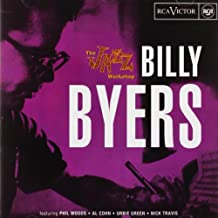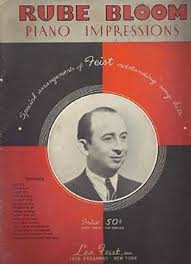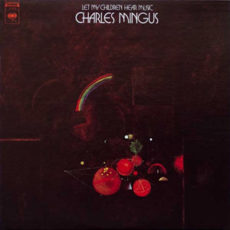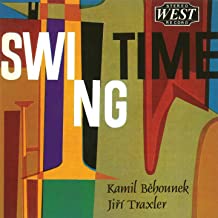
Daily Dose Of Jazz…
Billy Byers was born on William Mitchell Byers on May 1, 1927 in Los Angeles, California. He picked up the trombone and played with Karl Kiffle before serving in the Army in 1944–45. In the second half of the 1940s, he arranged and played trombone for Georgie Auld, Buddy Rich, Benny Goodman, Charlie Ventura, and Teddy Powell.
Following this period of playing, Byers composed for WMGM (AM) radio and television in New York City. During the mid-1950s, he was living and arranging in Paris, France where he also led a session as a leader, released as Jazz on the Left Bank, at this time. Later in the 1950s in Europe, he played with Harold Arlen (1959–1960) and with the Quincy Jones Orchestra. Becoming Quincy’s assistant at Mercury Records in the Sixties, he arranged for Count Basie albums.
He also led some recording sessions of Duke Ellington standards, toured Europe and Japan alongside Frank Sinatra in 1974, and had extensive credits arranging and conducting for film. Billy won the Drama Desk Award for Outstanding Orchestrations for the City of Angels.
He recorded with Count Basie, Bob Brookmeyer, Al Cohn, Billy Eckstine, Coleman Hawkins, J. J. Johnson, Lee Konitz, Jack McDuff, Gary McFarland, Hal McKusick, Carmen McRae, Joe Newman, Lalo Schifrin, Bud Shank, Charlie Shavers, Julius Watkins, Andy Williams, Cootie Williams, Kai Winding, and Frank Zappa. With four albums as a leader and another twenty-eight as a sideman, trombonist Billy Byers, passed away in Malibu, California, on May 1, 1996.
More Posts: arranger,bandleader,history,instrumental,jazz,music,trombone

Daily Dose Of Jazz…
Reuben Bloom was born on April 24, 1902 in New York City, where he learned to play the piano. During the 1920s he wrote many novelty piano solos which are still well regarded today. He recorded for the Aeolian Company’s Duo-Art reproducing piano system various titles including his Spring Fever.
In 1927 Rube had his first hit with Soliloquy and his last hit was “Here’s to My Lady” in 1952, which he wrote with Johnny Mercer. In 1928, he made a number of records with Joe Venuti’s Blue Four for OKeh Records, including five songs he sang, as well as played piano.
He formed and led a number of bands during his career, most notably Rube Bloom and His Bayou Boys. They recorded three records in 1930 that are considered some of the best made during the early years of the Depression. The Bayou Boys was an all-star studio group consisting of Benny Goodman, Adrian Rollini, Tommy Dorsey and Mannie Klein. At other times, Bloom played with other bands, such as with Bix Beiderbecke and Frankie Trumbauer in the Sioux City Six as well as his continued frequent work with Joe Venuti’s Blue Four.
During his career, Rube also worked with many well-known performers, including Ruth Etting, Stan Kenton, Jimmy Dorsey. He collaborated with a wide number of lyricists including Ted Koehler, and Mitchell Parish. During his lifetime he published several books on the piano method.
Bloom’s I Can’t Face the Music with lyrics by Ted Koehler was recorded by Ella Fitzgerald on her 1962 Verve release, Rhythm is My Business, in a fabulous swing/big band version with Bill Doggett. Some of his best-known composition collaborations with lyricists were Day In, Day Out and Fools Rush In (Where Angels Fear to Tread) with lyrics by Johnny Mercer; Give Me the Simple Life with Harry Ruby; and Maybe You’ll Be There with lyrics by Sammy Gallop.
Pianist, vocalist, songwriter, arranger, bandleader, recording artist, and author Rube Bloom passed away on March 30, 1976 in his hometown.
More Posts: arranger,author,bandleader,history,instrumental,jazz,music,piano,recording artist,songwriter,vocal

Daily Dose Of Jazz…
Sy Johnson was born on April 15, 1930 in New Haven, Connecticut and learned to play the piano in his youth. He first performed in New York City with Charles Mingus at the jazz club Showplace, with Booker Ervin on tenor, Ted Curson on trumpet, Dannie Richmond on drums, and Mingus on bass. and on his first night with Mingus, Eric Dolphy performed on alto, bass clarinet, and flute.
In 1971, eleven years later, Mingus gave Johnson Let My Children Hear Music to arrange, which featured two Mingus pieces, Shoes of the Fisherman’s Wife (Are Some Jiveass Slippers) and Don’t Be Afraid, the Clowns Afraid Too. The album’s emergence was heralded with a live concert, Mingus And Friends At Philharmonic Hall, also arranged by Johnson and released as an album.
Performing We Did It on Soul Train in 1973 and continued to work with Mingus until his death from Lou Gehrig’s disease in 1979. Mingus recorded two of Johnson’s compositions, Wee and For Harry Carney, and nominated Johnson for a Guggenheim award following his own in Jazz Composition.
Johnson continues to work with Sue Mingus arranging charts for all the Mingus repertory ensembles—the Mingus Big Band, the Mingus Orchestra and the Mingus Dynasty. He would go on to collaborate with arrangements for Joe Williams, Frank Sinatra, Wes Montgomery, Roy Eldridge, Ben Webster, Quincy Jones, Benny Goodman, Count Basie, Mel Torme, Terry Gibbs, Lee Konitz and Sarah Vaughan, among others.
He has also worked on Broadway and in films such as the1984 movie The Cotton Club. Arranger Sy Johnson is also a jazz photographer, writer, pianist, singer, and teacher.
More Posts: arranger,history,instrumental,jazz,music,photographer,pianist,singer,teacher,writer

Daily Dose Of Jazz…
Kamil Běhounek was born on March 29, 1916 in Blatná, Czech Republic and was an autodidact on accordion, having learned to play by imitating recordings and BBC broadcasts. While studying law in Prague he began performing in clubs and recorded his first solo accordion date in 1936. By the late 1930s, he was working with the Blue Music Orchestra, Rudolf Antonin Dvorsky, Jiří Traxler, and Karel Vlach.
In 1943, he was forcibly compelled by the Nazis to go to Berlin and make arrangements for the bands of Lutz Templin and Ernst van’t Hoff. Upon returning to Czechoslovakia in 1945, he used some of these arrangements for his own band, then returned to Germany the following year, where he continued arranging for bandleaders such as Adalbert Luczkowski, Willy Berking, Heinz Schönberger, and Werner Müller.
He played with his own ensemble, including in Bonn, Germany and after 1948 he performed in West Germany at American soldiers’ clubs. Between 1968 and 1977 he recorded several albums of folk music but continued to play swing with his own groups. He also wrote an autobiography, Má láska je jazz (Jazz is my Love), which was published posthumously in 1986.
Bohemian accordionist, bandleader, arranger, composer, and film scorer Kamil Běhounek, who occasionally played tenor saxophone, passed away on November 22, 1983 in Bonn, Germany.
More Posts: accordion,arranger,bandleader,composer,film scorer,history,instrumental,jazz,music,saxophone

Daily Dose Of Jazz…
David Burns was born on March 24, 1924 in Perth Amboy, New Jersey and began playing trumpet when he was nine years old. As a teenager, he heard bebop performances at Minton’s Playhouse, among others Dizzy Gillespie. His first ensemble was in Al Cooper’s Savoy Sultans, with whom he played from 1941 to 1943, prior to joining the Army Air Force. There he led a band from 1943 to 1945 that included James Moody as a sideman.
He joined Gillespie’s band in 1946 and appeared with Gillespie in Jivin’ in Bebop in 1947. After leaving Gillespie’s band in 1949, he worked with Duke Ellington from 1950 to 1952 and then with James Moody until 1957.
The late 1950s saw Dave playing shows in New York City and in the Sixties recorded for Vanguard Records. He worked with Billy Mitchell, Al Grey, Willie Bobo, Art Taylor, Dexter Gordon, Johnny Griffin, Leo Parker, and Milt Jackson. From the 1970s through the end of his career he increased his work as an educator. Trumpeter, flugelhornist, arranger, composer, and teacher Dave Burns passed away on April 5, 2009 in Freeport, New York.
More Posts: arranger,composer,educator,flugelhorn,history,instrumental,jazz,music,trumpet




